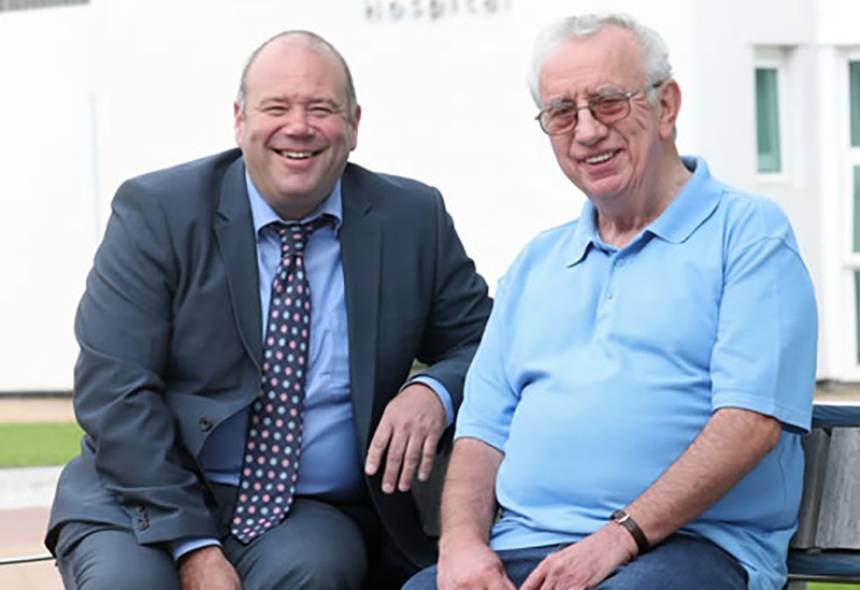Hip replacement gives Newport gentleman new lease of life
Date Posted: 1st October 2019

In England and Wales approximately 160,000 total hip and knee replacement procedures are performed each year.
Medical advances mean that hip replacement operations are now less invasive, and the implants last for longer than ever before. This has led to a rise in the number of people receiving the surgery – at St Joseph’s Hospital in Newport, the number of hip replacement procedures performed in its Orthopaedic Surgery Centre of Excellence increased by more than 40% from 2017-2018.
Hip replacements are usually performed when patients experience severe pain in their hip joint that affects their quality of life, but not all cases are so straight forward. Colin Swenson is one of St Joseph’s more unusual cases. The 73-year-old underwent a total hip replacement in March, just four weeks after his first consultation, but didn’t suffer with any discomfort in his hip and instead complained of pain in his right knee.
Mr Swenson said: “The pain in my knee first started about 10 years ago. It got worse over time and eventually started to really affect my quality of life; I found it very painful to move and couldn’t walk very far. I developed a limp and my friends and family started to tell me I was bent over. Simple things like walking to the pub to meet my friends or sitting on the floor to play games and do drawings with my four-year-old granddaughter were impossible.
“I saw my GP about it several times over the years. They booked me in for X-rays and scans but they told me they couldn’t find anything wrong with my knee. It was frustrating to be in so much pain and be told that there wasn’t anything physically wrong. They tried giving me painkillers and physiotherapy but nothing offered long-term relief.
“A few months ago, I went to see a new GP and told them about the difficulty I was having getting a diagnosis. They advised me to see a Consultant Orthopaedic Surgeon to get a specialist opinion and referred me to Mr Aled Evans at St Joseph’s Hospital.
“As soon as I explained my situation, Mr Evans asked me to walk up and down the room for him. He told me right away that my right hip was stiff and he thought that was causing the pain, there wasn’t anything wrong with my knee. He arranged an X-ray for me that morning and within half an hour we knew that the problem was my hip and the pain in my knee was caused by me compensating for the stiffness in the joint. I was really impressed by how quickly he was able to diagnose the problem I had been living with for so long.
“Mr Evans explained that the most effective way of relieving the pain would be to have a total hip replacement. I didn’t have to think about it for very long, the pain in my knee was affecting my quality of life so much that I was willing to try anything to get back to normal, I decided to go for the operation.
“I was due to go away for a long weekend to Edinburgh so Mr Evans arranged for me to have all the pre-op checks I needed before I left and booked in my surgery for just after I got back. I ended up having my hip replacement about four weeks after my first appointment, and I could have had it even sooner if I hadn’t been going away.
“I was awake throughout the procedure but it wasn’t at all uncomfortable or unpleasant. The operation went well and I felt like I recovered very quickly, I was up and about after two days and only had to spend four nights in hospital. The doctors at St Joseph’s put me on a tailored recovery plan which included medication to prevent infection, physiotherapy sessions and exercises for me to do at home.
“I had three sessions at the Clinical Physiotherapy Centre over a two-month period. I found the physiotherapy incredibly helpful, particularly the anti-gravity walking machine and hydrotherapy. I still practice the hydrotherapy exercises developed for me. They also set me exercises to do at home including ‘Alphabet Exercises’ which involve writing letters of the alphabet using my feet. I still practice these at home now and it’s really helped me to get the range of motion back in both legs.
“I’ve been delighted with the results. For the first couple of weeks I still had some discomfort in my knee but now that’s completely gone and I had very little pain in my hip from the operation. I started off walking with two sticks, then went down to one and now I don’t need to use one at all. I feel like I’ve got my freedom back, I can do all the things I was missing before. My granddaughter is over the moon that I can now play games and run around with her in the garden.”
The Centre of Excellence for Orthopaedic Surgery at St Joseph’s Hospital is renowned for the quality of care it provides. With 20 highly qualified orthopaedic specialists including many of the most qualified consultants in Wales and the South West of England, the Centre provides patients with a bespoke service specifically suited to their needs and focussed upon the fastest possible route to full recovery and rehabilitation.
Hip, knee, shoulder and elbow patients having joint replacement or other reconstructive or remedial surgery at St Joseph’s Hospital also benefit from the Rapid Recovery Programme delivered in partnership with Zimmer-Biomet. The programme is only available in South Wales and the South West of England through St Joseph’s Hospital and has produced very significant improvements in the time patients take to reach full recovery and rehabilitation.
Click on the link to discover more about hip replacement surgery or knee surgery.



